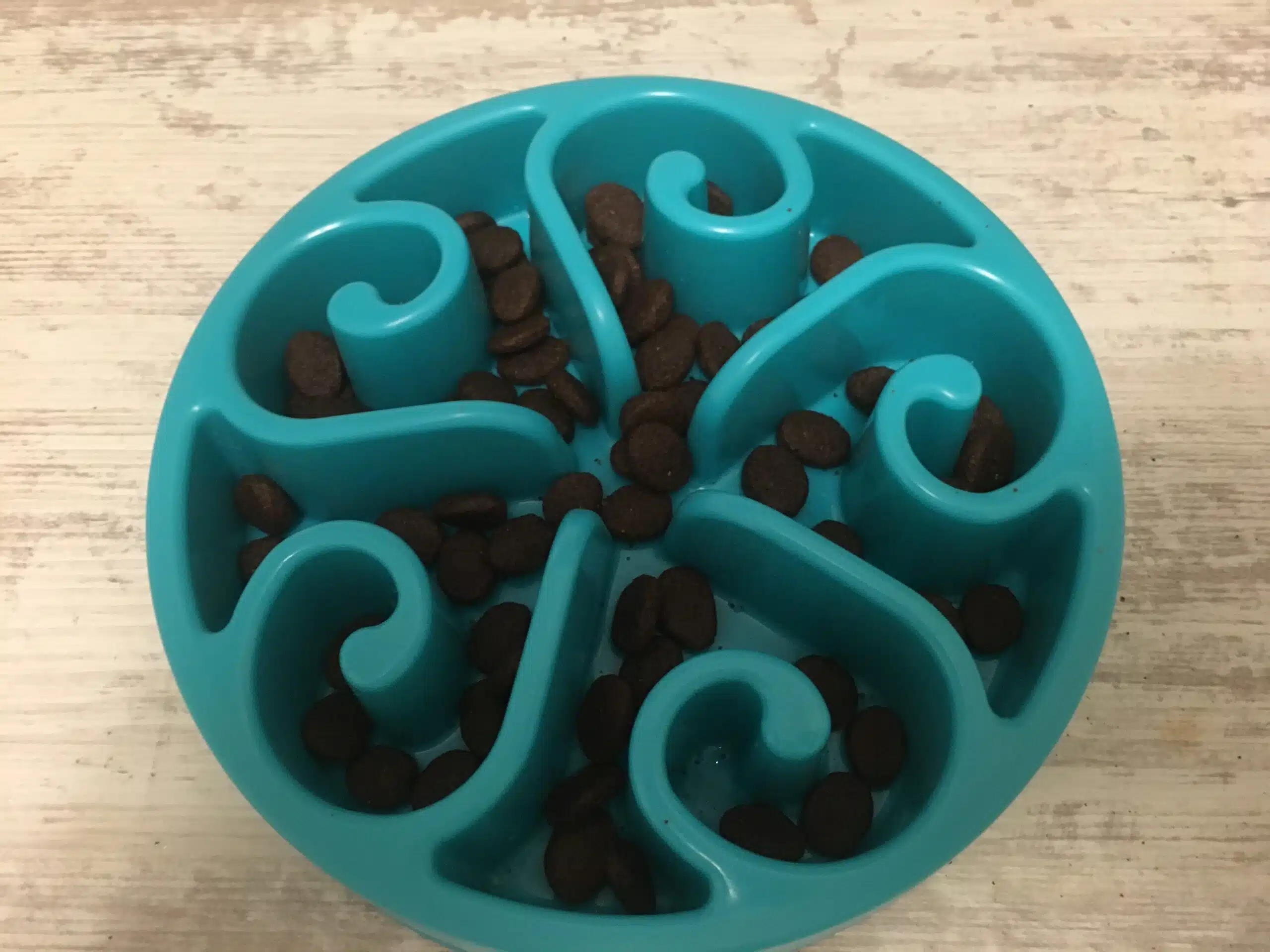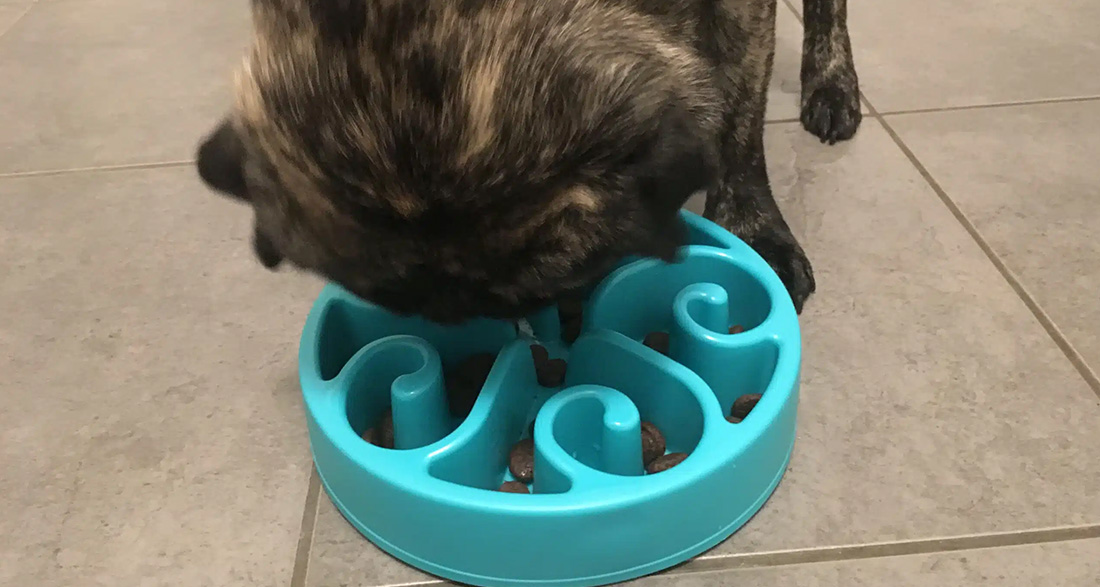Does your dog devour its food way too quickly? Rapid eating can harm your pet’s digestion: your dog can choke, burp, bloat, and even vomit. We’ll show you how helpful an anti-gobble bowl can be and what benefits it offers.
Why do dogs gulp down food in the first place?
The most common reasons why dogs eat their food too quickly include:
1. Competition
Some dogs learn this behavior because they may come from a fairly large litter. In such cases, every meal is a competition for food.
On the other hand, some dogs are habitual fast eaters and hardly have time to breathe while wolfing down their meals.
This can make mealtime even more challenging when multiple dogs eat at different paces, creating a competition among them.
Determine if your dog is a competitor. Do you have more than one dog?
You may observe that your dog eats quickly because it fears the other dog will steal its food.
It may also eat quickly to consume the other dog’s food. This behavior is referred to as competitive eating.
In such a conflict situation, feed your dogs from separate bowls, at opposite ends of the room.
This allows each dog to eat from its own bowl without feeling pressured by the other dog breathing down its neck.
If the greedy dog is determined to steal food, feed it in a different room.
This relieves the victim dog and eliminates the temptation to provide the greedy dog with additional food.
2. Untimely Feeding
You may find that your dog still rushes or eats the leftovers of another dog out of habit. This could be due to food insecurity.
Timely feeding creates a sense of food security.
Your dog may have had an unpleasant experience that made it feel this was necessary.
For example, the previous owner was late coming home, and the hungry dog found leftovers from an uneaten meal.
When the next meal appeared, it devoured its food and searched for leftovers (from its buddy’s bowl) out of a sense of nutritional insecurity.
3. Parasites
Another reason can be attributed to illnesses like parasites, which affect the body’s ability to absorb nutrients.
Then your dog may constantly feel hungry and eat greedily at every meal. Watch the weight, as it could be a cause of being underweight.
Switching to something nutritious may change your pet’s eating habits and allow it to eat more slowly. Also, if you suspect parasites, be sure to consult your veterinarian.
The Benefits of an Anti-Gobble Bowl
Eating too quickly can lead to a life-threatening condition. A well-known disease called “Gastric Dilation,” more precisely “Stomach Torsion,” is one of the illnesses that has fatal consequences.
Bloating in dogs can be caused by eating too much or too quickly.
The stomach expands as gases build up so much that they can twist inside the dog’s abdomen. This prevents the gases from leaving the stomach.
This can cause circulation to be cut off to both this organ and others, including the heart.
Dogs can die within hours of bloating, so it is a serious condition that requires immediate medical attention if you even suspect it may be possible.
Early signs of bloating are excessive panting, drooling, and vomiting!
Watch out for esophageal obstruction
Due to fast eating, food gets stuck in the esophagus, causing the esophagus to react with spasms. The ingested food ultimately remains stuck in the esophagus and cannot be swallowed down.
Reasons why fast eating must be controlled include the fact that it can lead to choking since they fail to stop and properly chew the food. The dog may also become possessive, leading to aggression towards anyone who stands between it and its food. In households with small children or other dogs, this can be extremely dangerous as they may attack anything when in contact with food.
Training for Slow Eating
Now, for the answer: You can train slow eating by making the food physically less accessible to him.
What does that mean? There are many ways. The most commonly used technique is to get an anti-gulp bowl or to make one yourself. It will not allow your dog to gulp everything down in seconds but will automatically slow him down with the built-in obstructions.
DIY: Make Your Own Anti-Gulp Bowl
You can place a small bowl upside down inside a larger bowl and then pour the food over the small bowl into the larger one. This creates a tight “moat”, and the dog cannot swallow the entire meal. He must work his way around the entire circumference of the food.
In order to get all the food, he has to circle the bowl and move his head up to switch to the other side. Even something as simple as this can slow him down while eating and does not require any new equipment.
Stones used for garden decoration are also an option if they are really large enough and there is no risk of swallowing.
Another alternative is to place toys that are too large to swallow (and are clean!) into a food bowl. This forces your dog to either move them out of the way or work around them to reach the food.
Either divide the food into several small saucers or use muffin or cupcake molds. This way, your dog can occasionally catch his breath between bites.
For dog owners whose pets tend to inhale a bowl of food in seconds, they scatter the food over a wide area. The dog has to move for each piece of food. This works well with a single dog. If there is more than one dog nearby, this option is a poor choice. It promotes competition and stress, which can lead to aggression during feeding.
If all else fails, place the bowl on a low table or chair. This forces the dog to place its paws on the surface, and it tilts its esophagus downward. This helps reduce the amount of swallowed air. It also raises its head to facilitate belching.
What Material Should the Bowl Be Made of?
Out of love for our new family members, we sometimes like to spoil them. We pay attention to color, shape, and extras around them.
If you are faced with the problem of how to prevent gulping and want to make a bowl yourself, I recommend buying one made of plastic. If you opt for a stainless steel bowl and build obstacles out of stones, it can cause uncertainty in the dog. These stones make too much noise and can cause feelings of fear.
With the same idea, I also advise against using a ceramic bowl as they can easily break.
Practical Solution: Anti-Gulp Bowl

After experiencing it with my dog, I see the anti-gulp bowl as a good solution that you should definitely consider using.
While not everything works, you may find something that helps your dog. Keep in mind that it will take some time for him to learn to eat more slowly.
If you still find that your dog is greedy or aggressive, this may be more of a possessiveness issue. In short, it’s a problem with fast eating.
But don’t neglect to consult a veterinarian so that your furry friend can be examined for any underlying conditions.
In Case of Emergency
Watch out for signs of bloating. This can be a warning sign of gastric dilation.
Other symptoms may include:
- Bloated or swollen belly
- Hunched walking
- Unsuccessful attempts to vomit
- Listlessness
- Restlessness
Call the vet if you suspect gastric dilation. This is an emergency, and it’s better to make one too many phone calls than to miss a life-threatening problem.
Feeling full from food can increase the likelihood of your dog’s stomach twisting, cutting off blood flow to the stomach.
This can cause damage to the stomach or lead to death. A dog suffering from this condition must be seen by a vet immediately. There is no home remedy.
My Conclusion
First, you should determine the cause of your dog’s fast eating. Your vet can definitely help you with this.
In any case, an anti-gulp bowl is recommended. This reduces the risk of your dog suffering from diseases such as gastric dilation or gastritis due to gulping down his food.


